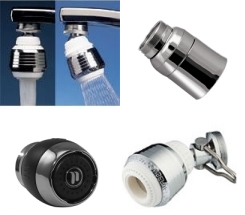Though the kitchen can sometimes double as a family room – with all the laughter and delicious smells mingling together – , having family-sized water waste is no one’s idea of a good time. Luckily, from the faucet to the dishwasher, there are many simple ways to save water in the kitchen.

The Faucet: Why Aerators are Important
Have you ever turned on the outside faucet without a hose attached? See how freely the water flowed? Aerators keep the kitchen faucet from acting like the outside tap by reducing the flow of water. Some aerators go even further by using an off/pause valve that temporarily stops the water stream.
How it Works
An aerator is like a ring with a small mesh screen in the middle. Installed on the tip of a faucet, aerators reduce water flow by adding air to the water (for a visual of how this works, pour water through a strainer with very little openings). Even though less water is being used, aerators allow the water pressure to stay pretty much the same.
Savings
Installing faucet (or tap) aerators is one of the cheapest ways to save water. For your investment of as little as $1.15, you could reduce water usage by 30-50%!
Installing
Can you open and close a bottle of water? Then you can install an aerator.
- First off, make sure that you need to change the aerator you have (or install one for the first time). To determine if you need a new aerator, check the sides to see what the GPM (gallons per minute) is. If it’s more than 2.5, than you need a new aerator. Ideally, you want an aerator that dispenses 0.5-1.5 gallons of water per minute.
- Now find out which threading, or type of aerator for your spout, is needed. If the faucet tip is male, or has edges that go around the outside of the tip, than you need female threading. It the faucet is female, or has edges on the inside of the tip, than you need male threading.
- Simply twist it on and you’re done!
Dishwasher: An Upgrade is in Order
Dishwashers are a must in every household, which is why getting an energy and water efficient model is one of the best ways to save water. If the dishwasher in your home has been in use since 2003 or earlier, it’s time for a change. Dishwashers that are 10+ years old waste as much as 50% more water and energy than newer models.
Keep it Simple – Just use less water!
The opportunities to save water in the kitchen are endless. A few tips to get you started include:
Don’t run the faucet
- Rinsing off vegetables for a dinner? Instead of letting the water run, fill up a bowl with water and rinse your veggies in the bowl.
- Washing your hands in a double-sink? Fill one sink with soap water for washing and the other for rinsing.
- We always tell kids to turn off the water while brushing: we should do the same. Up to 8 gallons of water can be saved from that one act alone.
Reuse Water
- Draining water from pasta? Use that leftover water to cook a broth or soup.
- If you have a glass of water or two lying around that you neglected to finish off, why not use it to water your plants?
Mind the Dishwasher
Though newer models are more energy and water efficient, all of that is thrown away if the dishwasher is run 3+ times throughout the day. Only run the dishwasher when it’s full.
Putting these tips to use will immediately impact your home’s water and energy bills and (better yet) make family-sized water waste is a problem of the past.
